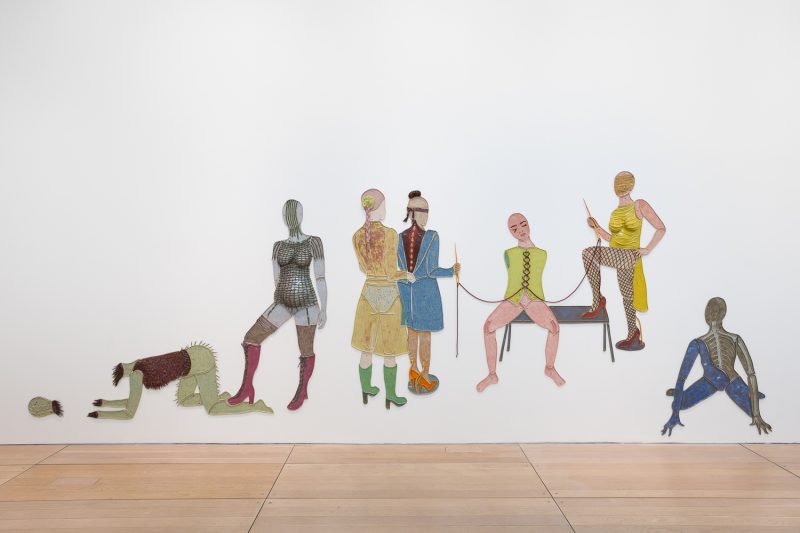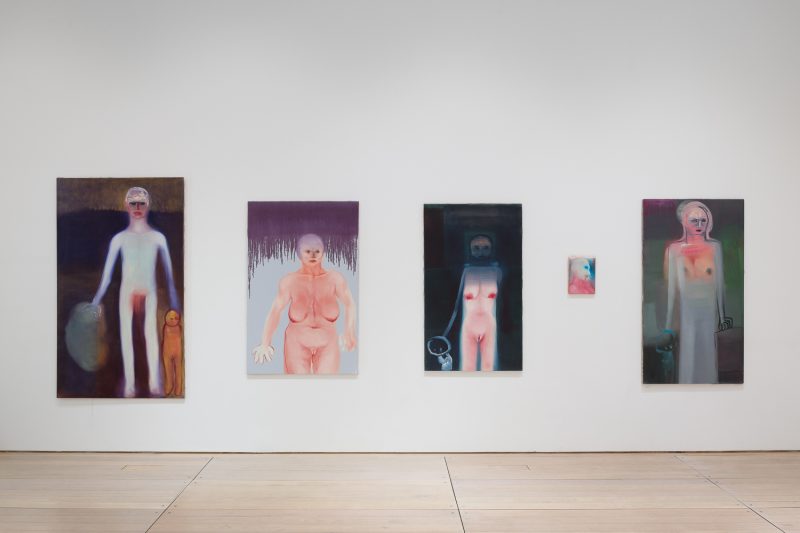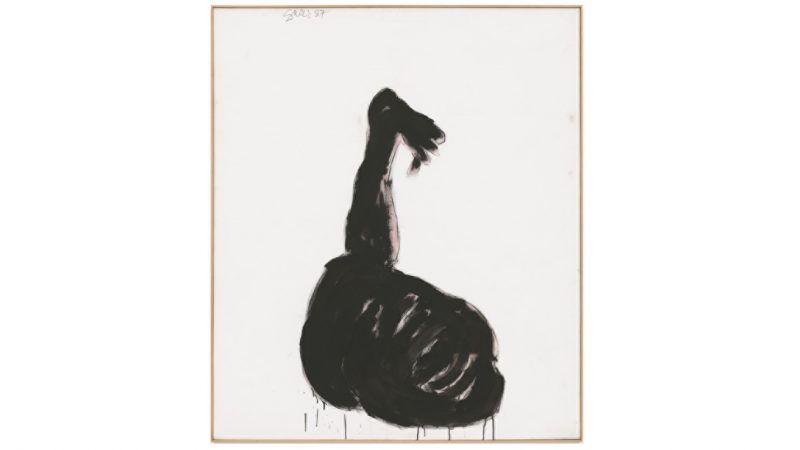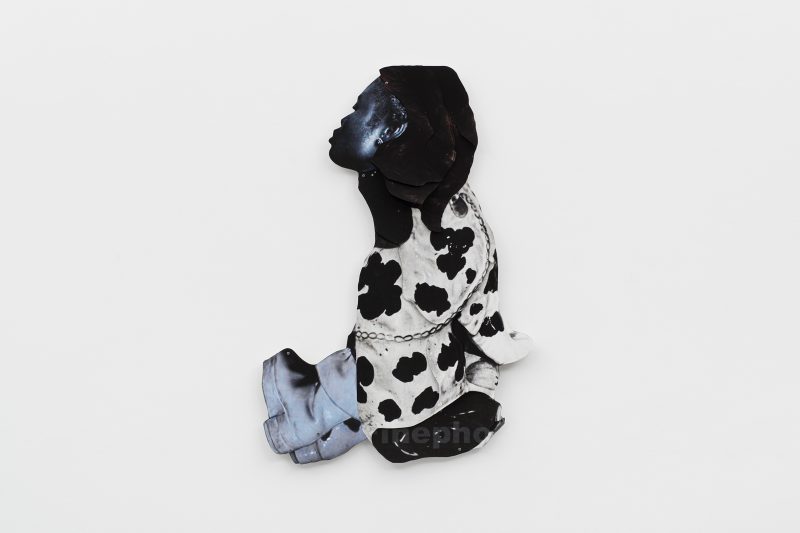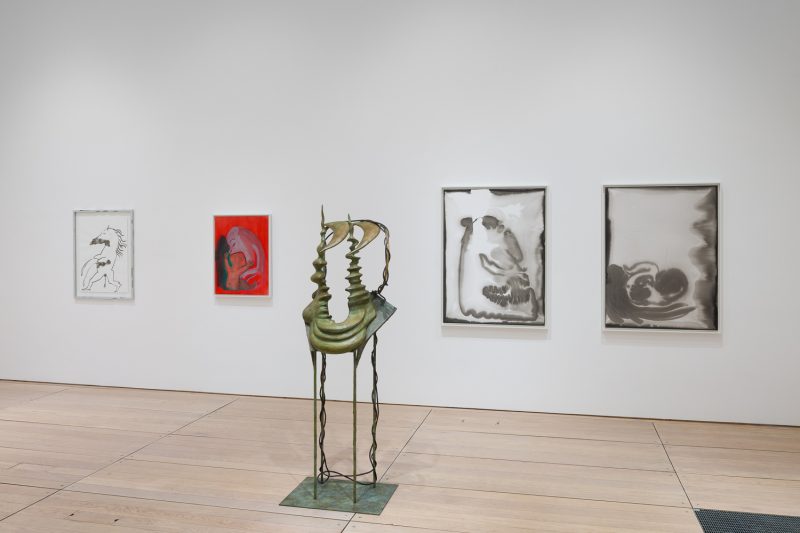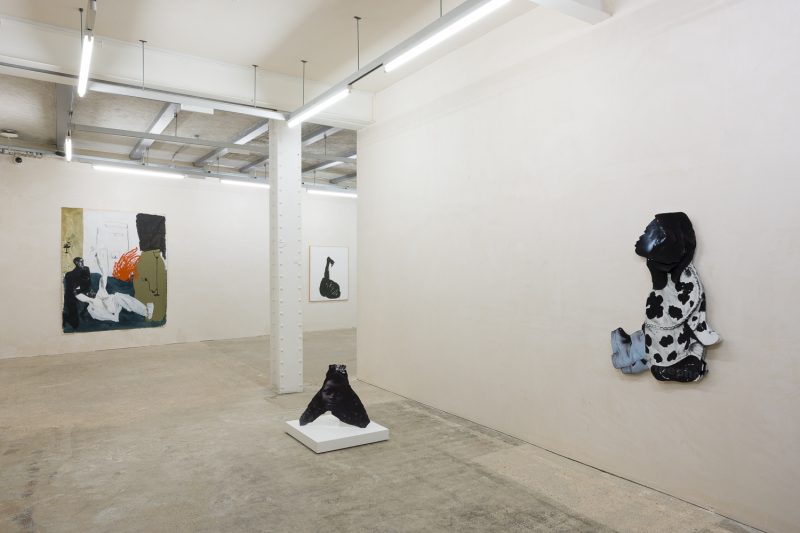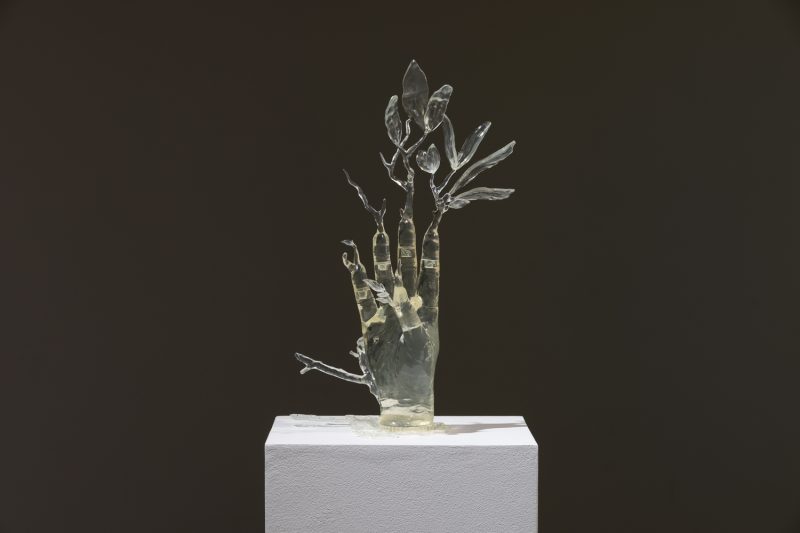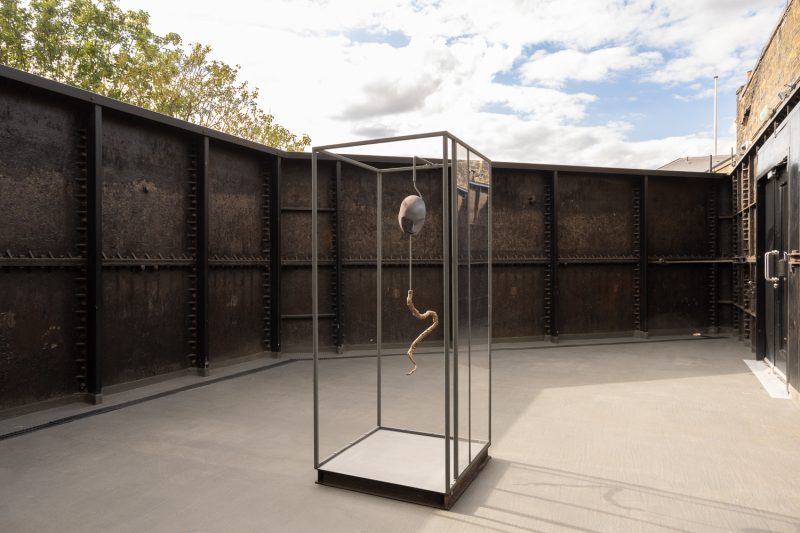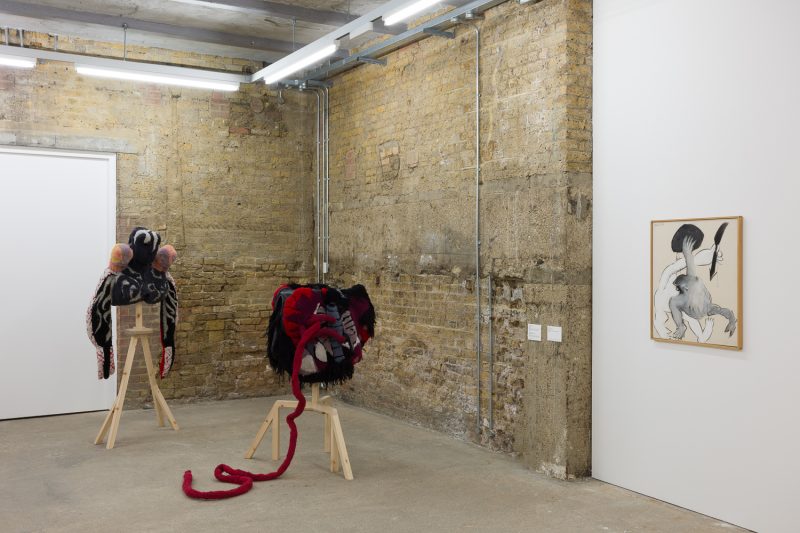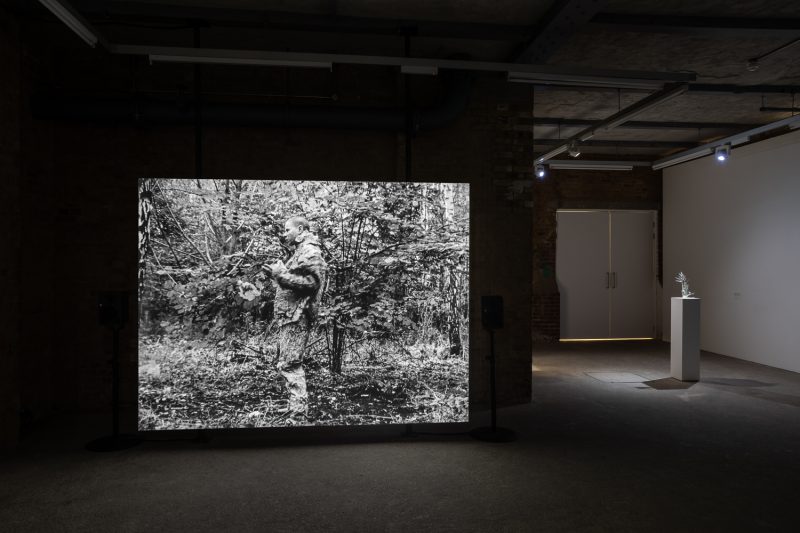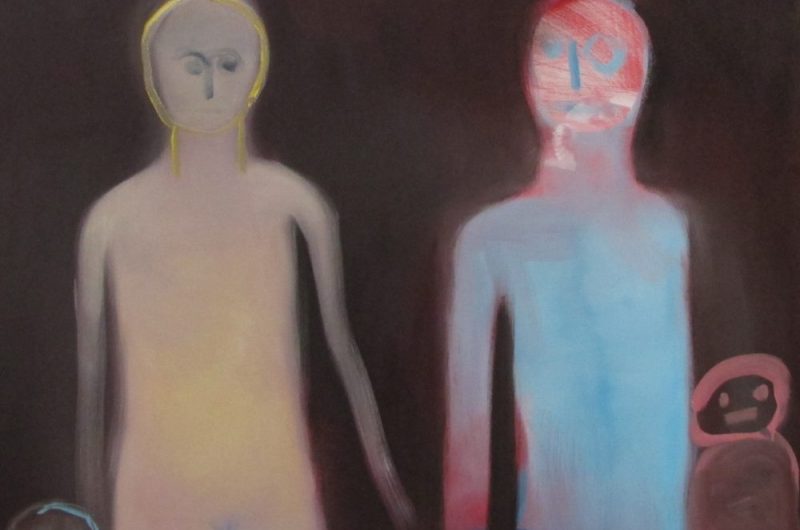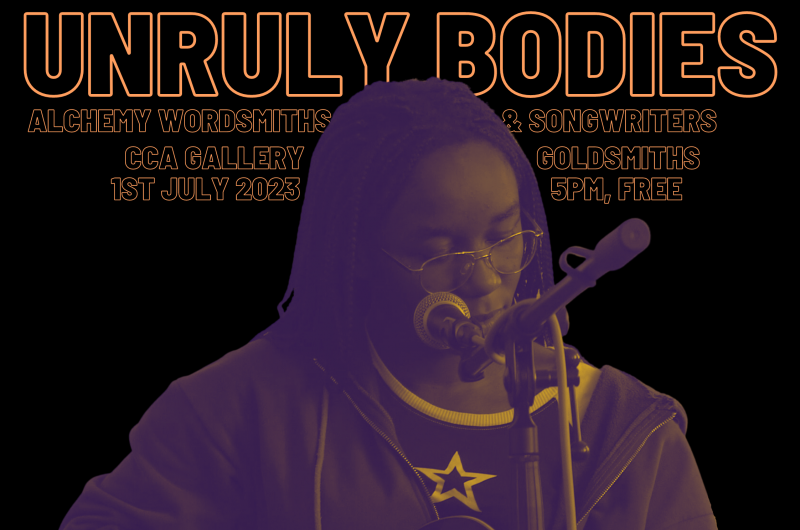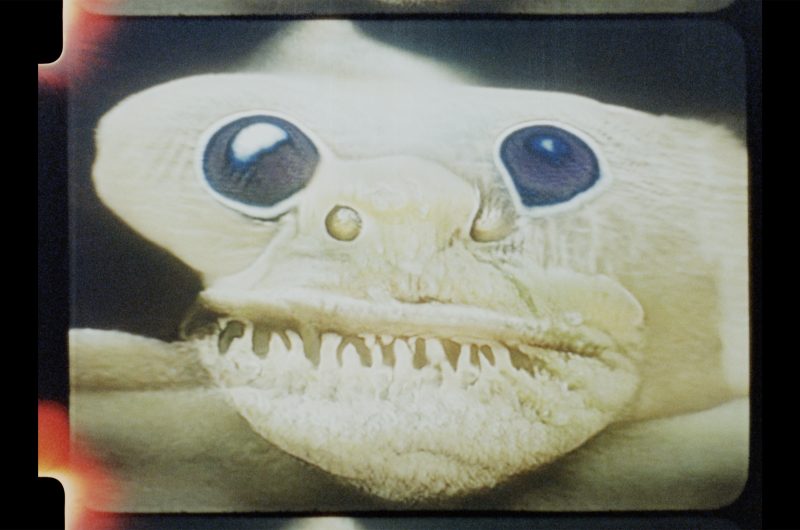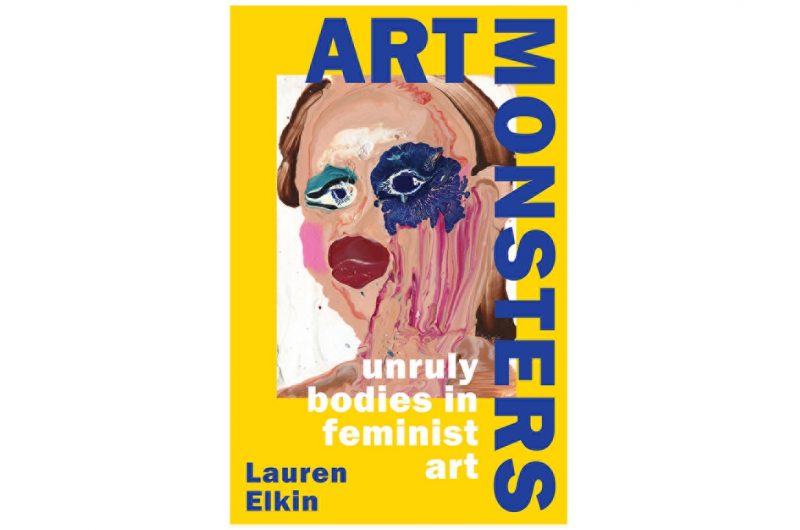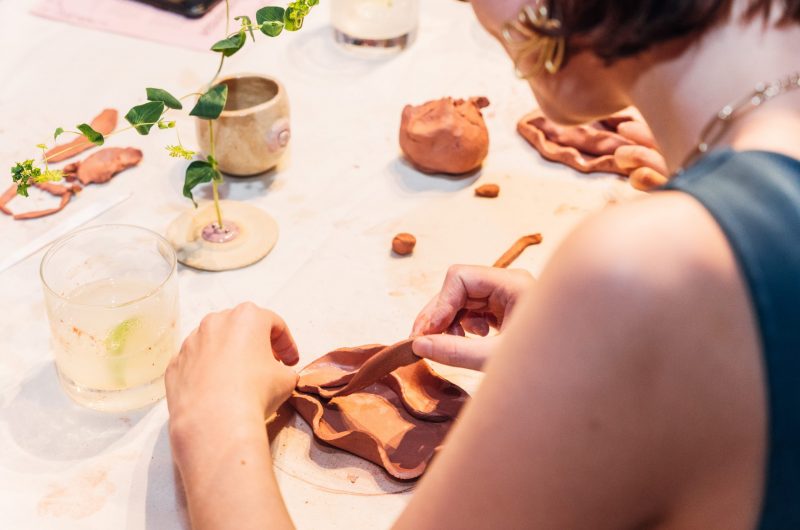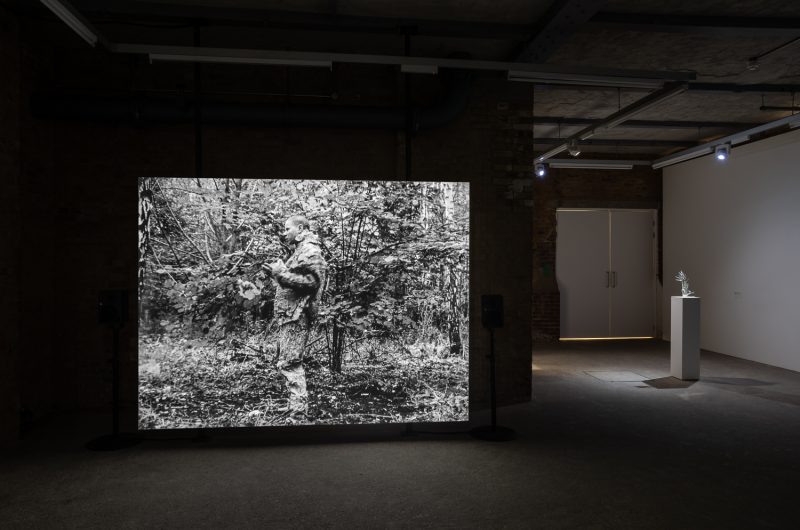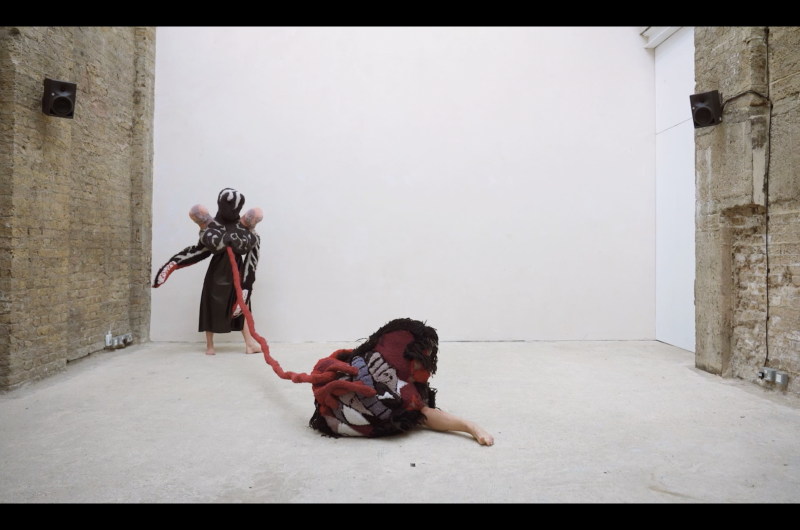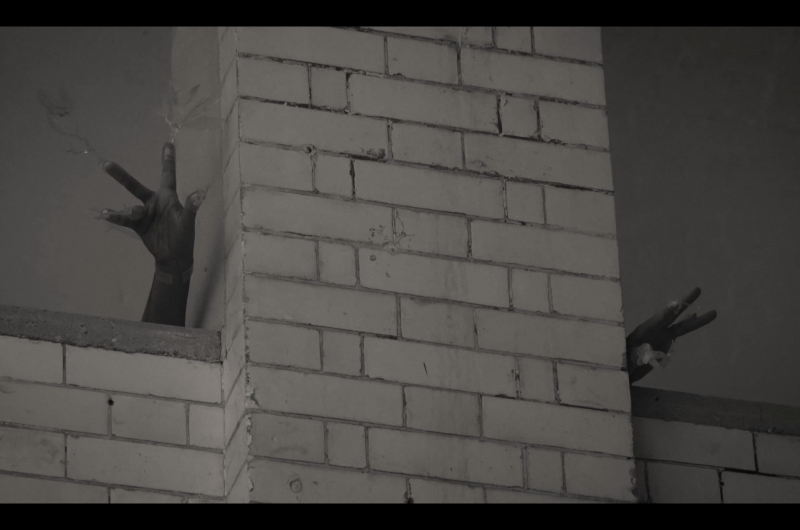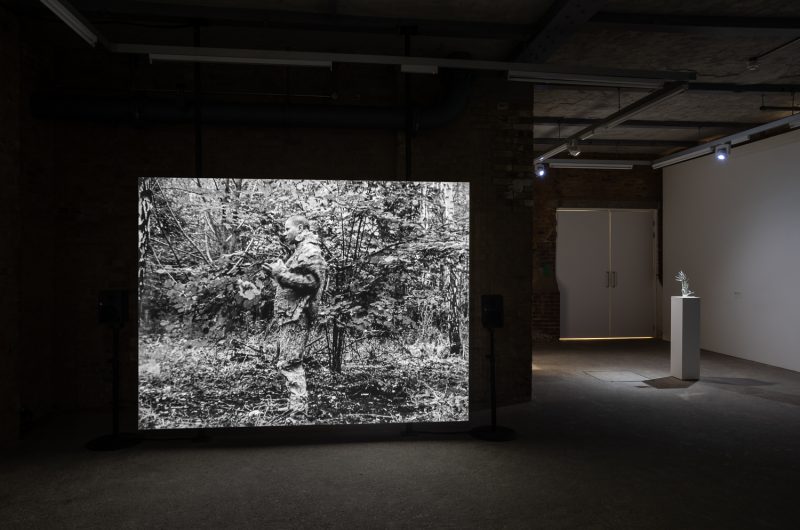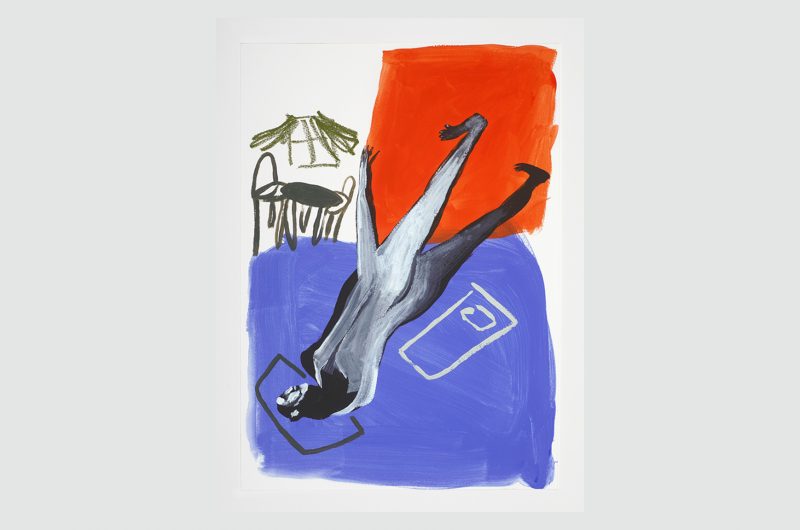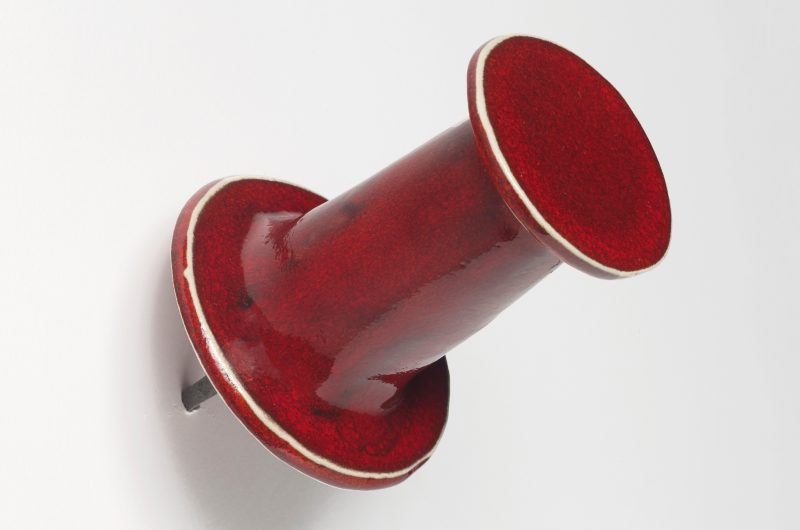UNRULY BODIES
Participants: Shadi Al-Atallah, Giulia Cenci, Miriam Cahn, Camille Henrot, Galli, Ebecho Muslimova, Frida Orupabo, Anna Perach, Paloma Proudfoot, and collectively Clémentine Bedos, Verity Coward, Assia Ghendir, Holly Hunter.
‘I want to lay claim to the dark power of my monstrous identity without using it as a weapon against others or being wounded by it myself.’ [1]
Featuring thirteen women and non-binary artists, Unruly Bodies presented artworks that explored the experience of embodiment today. The exhibition included work that presents the body as monstrous, abject, grotesque, and liminal. The exhibition asked why this kind of figuration has become ubiquitous in contemporary art, where rather than being a negative attribute, the unruly body is a site of resistance in which monstrosity is reclaimed as a subjectivity that disrupts normativity and contests power.
The exhibition followed Paul Preciado’s idea of the body as a ‘somatheque’, or a living archive that records the disciplining forces it has been subject to. Whether through gesture, action, or abstraction, the bodies in the exhibition viscerally evidenced the emotional turbulence produced by living under conditions of patriarchy, misogyny, racism and ableism. Against the smooth and unified surface of normativity, the unruly body leaks, breaks apart, and laughs.
Artists in the exhibition drew on traditions of the grotesque, and abject, but shot through these intersectional realities that expand and revise the terms. Historically held in a ‘low’ position, the unruly body is implicitly female, Black, crip, queer or other. The adoption of the aesthetic of the monster claims space for lived experiences that do not fit neatly into acceptable social conventions, and for those that are held as less-than-human. Through its liminality, and troubling of categories, the unruly body offers the possibility that the self is not fixed, but rather a complex web of interrelations in a constant state of flux.
[1] My Words to Victor Frankenstein above the Village of Chamounix; Performing Transgender Rage. Susan Stryker. 1994.
SUPPORTERS:
Crozier Fine Arts
Spazio A, Pistoia
Soy Capitan, Berlin
Read more…
BIOGRAPHIES
Metamorph is a long-term collaboration between Clémentine Bedos, Holly Hunter, Verity Coward and Assia Ghendir. The multi-disciplinary project, which includes 16mm film, along with prosthetics, text, sound and performance-based works, draws on the classical myth of Daphne; the nymph who transformed into a laurel tree in order to escape being raped by the god Apollo. In Metamorph, this narrative – which is traditionally interpreted as resulting in Daphne’s ‘eternal silence’ or ‘loss of self ’ – is reframed through a queer, transcultural and multi-species lens to consider alternative interpretations around issues of consent and social agency in their becoming-tree, and their relationship to landscape.
Shadi Al-Atallah is a multi-disciplinary artist working between London and Bahrain. Their life-sized distorted self-portraits explore mental health, queerness, and racial identity, inspired by spiritual practices, family history and their childhood in Saudi Arabia. Shadi Al-Atallah’s own queer, mixed-race identity is bodied forth in vigorous, complex work that engages boldly with non-normative identities, composite cultural affiliations, spirituality, and mental health. Al-Atallah received their MA in Painting from the Royal College of Art in 2021, their work has been shown at Steve Turner, Guts Gallery, J. Hammond Projects, Cob Gallery, Perrotin, Christie’s Auction House, Sadie Coles HQ, Fitzrovia Gallery, Blank Projects, Swim Gallery, Spit and Sawdust, b.Dewitt, 198 Contemporary Arts, and Tate Modern.
Miriam Cahn (b. 1949, Basel, Switzerland) lives and works in Stampa, Bergell (GR), Switzerland. Solo exhibitions include Ma pensée sérielle, Palais de Tokyo, Paris, France. Venice Biennale, 2022, Venice, Italy. Gezeichnet, Foundazione ICA Milano, Milan, Italy, 2022. Me As Happening, The Power Plant, Toronto, Canada, 2021. Me As Happening, Kunsthal Charlottenborg, Copenhagen, Denmark, 2021. Fremd das Fremde, Palazzo Castelmur, Stampa, Switzerland, 2021.In 2022; Being in the world: The Tenth Anniversary of the Long Museum, Shanghai, China. R.A.W. or the sirens of Titan, Kunstmuseum Appenzell+Kunsthalle Appenzell, Switzerland. Résister, encore, Musée Cantonal des Beaux Arts, Lausanne, Switzerland. Edvard Munch. In Dialogue, Albertina Museum, Vienna, Austria. In 2021; Collection François Pinault, Bourse du Commerce, Paris, France Arcimboldo, Centre Pompidou-Metz, France. Crespo Foundation, Museum für Moderne Kunst, Frankfurt-am-Main, Germany Another Energy: Power to Continue Challenging, Mori Art Museum, Tokyo, Japan. In 2020: Is Humanism Dead?, MoMA, New York, USA, My Perversion is the Belief in True Love, Pori Art Museum, Pori, Finland. In 2017; Documenta Athens, Benaki Museum, Greece, 2017.
Giulia Cenci (b. 1988, Cortona, Italy) graduated at the Academy of Fine Arts in Bologna, IT (2007-2012), received a Master of Fine Arts at St.Joost Academy, Den Bosch-Breda, NL (2013-2015) and she took part in deAteliers residency, Amsterdam, NL (2015-2017). Cenci participated in the 59th Venice Biennale 2022, The Milk of Dreams, curated by C.Alemani, she was one of the shortlisted artists for the Maxxi Bulgari Prize 2020 and she won the Baloise Art Prize at Art Basel 2019. Giulia Cenci lives and works between Amsterdam and Tuscany. Selected solo shows: equal minds, SpazioA, Pistoia; dry salvages, P/////AKT, Amsterdam, NL (2023); Hijia del aire, Museo Blanes, Montevideo, UY (2022); Giulia Cenci, curated by M.N. Farcy, MUDAM Luxemburg, Luxemburg, L (2020); tallone di ferro, curated by S. Risaliti & E. Francioli, Museo del Novecento, Firenze, IT (2021); Da lontano era un’isola, curated by C. Rekade, Kunst Merano Arte, Merano, IT (2019); ground ground, SpazioA, Pistoia, IT (2019); a través, Carreras Mugica (Hall), Bilbao, ES (2017); Offspring 2017 – DEEP STATE, curated by L. Almarcegui and M. Hendriks, De Ateliers, Amsterdam, NL (2017); Mai, Tile Project Space, Milano, IT (2014). Group shows include: Reaching for the Stars. Da Maurizio Cattelan a Lynette Yiadom-Boakye – Sandretto Re Rebaudengo Collection, Fondazione Palazzo Strozzi, IT (2023); Strange – Sandretto Re Rebaudengo Collection, Centro Andaluz de Arte Contemporáneo, Siviglia, SP (2022); Shapeshifters, curated by Anna Johansson, Malmö Konstmuseum, Malmö, SE (2020); Metallo Urlante, Campoli-Presti, Parigi, FR (2020); 15th Lyon Biennale / Jeune création internationale, curated by Palais de Tokyo curatorial team, Institute of Contemporary Art, Villeurbanne/Rhône-Alpes, FR (2019); Comrades of time, curated by Whatspace, Hardspace, Basel, CH (2019); FutuRuins, curated by D. Ferretti, D. Ozerkov, con D. Dalla Lana, Palazzo Fortuny, Venezia, IT (2018); That’s IT!, curated by L. Balbi, MAMBO, Bologna, IT (2018); Figure di spago. Pratiche di narrazione, curated by Caterina Molteni, Fondazione Baruchello, Roma, IT (2018); Hybrids, curated by C. Driessen & D. Jablonowski, Lustwarande, Platform for Contemporary Sculpture, park De Oude Warande, Tilburg, NL (2018); Sessile, curated by J. Minkus, Clifford Gallery, Colgate University, Hamilton New York, USA (2016); Disappointment Island, curated by Galeria Stereo, Griffin Art Space, Varsavia, PL (2016); The Lasting. L’Intervallo e la Durata, curated by S. Cincinelli, GNAM, Roma, IT (2016).
Camille Henrot (b. 1978, France) is recognized as one of the most influential voices in contemporary art today. Over the past twenty years, she had developed a critically acclaimed practice, encompassing drawing, painting, sculpture, installation and film. Inspired by literature, second-hand marketplaces, poetry, cartoons, social media, self help and the banality of everyday life, Henrot’s work captures the complexity of living as both private individuals and global citizens in an increasingly connected and over-stimulated world. In 2013, Henrot received widespread critical acclaim for her film “Grosse Fatigue”, made during a fellowship at the Smithsonian Institution and awarded the Silver Lion at the 55th Venice Biennale in 2013. She elaborated ideas from Grosse Fatigue to conceive her acclaimed 2014 installation “The Pale Fox” at Chisenhale Gallery in London. The exhibit, which displayed the breadth of her diverse output, went on to travel to institutions including Kunsthal Charlottenburg, Copenhagen; Bétonsalon – Centre for art and research, Paris; Westfälischer Kunstverein, Münster, Germany; and Tokyo Opera City Art Gallery, Japan. In 2017, Henrot was given carte blanche at Palais de Tokyo in Paris, where she presented the major exhibition “Days Are Dogs.” She is the recipient of the 2014 Nam June Paik Award and the 2015 Edvard Munch Award, and has participated in the Lyon, Berlin, Sydney and Liverpool Biennials, among others. Henrot has had numerous solo exhibitions worldwide, including the New Museum, New York; Schinkel Pavilion, Berlin; New Orleans Museum of Art; Fondazione Memmo, Rome; Tokyo Opera City Art Gallery, Japan, and the National Gallery of Victoria, Melbourne, among others. Upcoming solo exhibitions include Lokremise St. Gallen (2023) and Fondazione ICA Milano (2023).
Galli (b. 1944, lives in Berlin) established herself in the West Berlin art scene in the late 1970s and early 1980s, when she carved out her own niche amidst the masculine transgression of the painterly style of Die neuen Wilden, by depicting bodies in states of vulnerability, disfigurement and ecstatic joy. From 1962 to 1967, Galli studied painting at the Saarland Art School in Saarbrücken. In 1969 she began further studies at the Hochschule der Künste in Berlin (today UDK). From 1992 to 2005, she taught at the FH Münster. Relevant exhibitions include Museum Frieder Burda, Baden-Baden (2023); Kunstmuseum Schloss Derneburg (2023); Nogueras Blanchard, Madrid (solo, 2023); Spaced Out, Gut Kerkow (solo, 2022); brunand brunand, Berlin (solo, 2021); 11th Berlin Biennale for Contemporary Art, KW, Berlin (2020); Haus am Lützowplatz, Berlin (solo, 2015); Saarländische Galerie im Palais am Festungsgraben, Berlin (solo, 2008); Kunstverein Augsburg (solo, 2005); Saarlandmuseum, Saarbrücken (2003); Museum St. Ingbert (solo, 2004); Musées de la Cour d’Or, Metz (2001); Stadtgalerie Saarbrücken (solo, 1992); Villa Romana, Florence (solo, 1990); Salzburger Kunstverein, Salzburg (solo, 1989); Städtisches Bodensee-Museum, Friedrichshafen (solo, 1985); Gropius Bau, Berlin (1983); Moderna Galerija Ljubljana (1983); Galerie der Berliner Festspiele, Berlin (solo, 1981); Max-Planck-Institut für Bildungsforschung, Berlin (solo, 1980); Modersohn-Becker-Haus, Bremen (solo, 1978).
Ebecho Muslimova (b. 1984, Dagestan) Muslimova received her BFA at Cooper Union in New York, NY in 2010. Muslimova has presented solo exhibitions at Magenta Plains, New York, NY; The Drawing Center, New York, NY; David Zwirner Gallery, London, UK; Galerie Maria Bernheim, Zürich, CH; White Flag Projects, St. Louis, MO and Room East, New York, NY. Her work has been included in group exhibitions at Kunstmuseum Basel, CH; ICA Miami, FL; Renaissance Society, Chicago, IL; Zuzeum, Riga, LV; Hirshhorn Museum, Washington, D.C.; Swiss Institute, New York, NY; Kunsthalle St. Gallen, CH. Her large-scale murals have been commissioned for biennials such as The Dreamers, 58th Edition of October Salon, Belgrade, RS and The 32nd Biennale of Graphic Arts: Birth As Criterion, Ljubljana, SI. In 2022 Muslimova was the recipient of the Borlem Prize, honoring artists whose oeuvre brings awareness to mental health issues & struggles. Her work has been featured in publications such as Forbes, The New York Times, Artforum, Art in America, Mousse, Artnet, Hyperallergic, and Cura Magazine, among others. Muslimova is included in Jeffrey Deitch’s book, Unrealism, featuring 27 artists and major essays by Johanna Fateman, Alison Gingeras, and Aria Dean.
Frida Orupabo (b. 1986, Sarpsborg, Norway) and lives and works in Oslo. Selected solo exhibitions include Nicola Vassell Gallery, New York, ny, usa (2022); Fotomuseum Winterthur, Switzerland (2022); Kunsthall Trondheim, Norway (2021); Hours After, Stevenson, Johannesurg, South Africa (2020); Medicine for a Nightmare, Kunstnernes Hus, Oslo; The Mouth and the Truth, Portikus, Frankfurt am Main, Germany (2019); and A House is a House, Galerie Nordenhake, Berlin, Germany (2019). Selected group exhibitions include Kiasma Finnish National Gallery, Oslo, Norway (2022); Hasselblad Foundation, Gothenburg, Sweden (2021); Stevenson, Cape Town, South Africa (2021); Huis Marseille, Amsterdam, the Netherlands (2020); Moderna Museet, Stockholm, Sweden (2019), Serpentine Gallery, London (2017). She has participated in the Munch Triennial, Munchmuseet, Oslo, Norway (2022); 34th Bienal de São Paulo, Fundação Bienal, São Paulo, Brazil (2021); and the 58th International Art Exhibition, Biennale Arte, Venice, Italy (2019).
Anna Perach (b. 1985, Ukraine) is an Israeli artist living and working in London, UK. She holds an MFA in fine art (distinction) from Goldsmiths, University of London (2020). In 2022 Anna presented a solo show with Edel Assanti in London and took part in Artissima with ADA gallery where she won the Carol Rama award. She has exhibited internationally at galleries including: Richard Saltoun (London, UK), Sommer gallery (Basel, Switzerland) and Herzliya Museum of Contemporary Art (Herzliya, Israel). In 2021 Anna took part in Arco Madrid 2021 with The Ryder gallery and received the Ingram prize award. In 2020 she received a studio award with Sarabande, The Lee Alexander McQueen foundation as well as the Gilbert Bayes award. Recent publications include Artforum and Art Maze Mag.
Paloma Proudfoot (b. 1992, London) is an artist living and working in London, with an MA (Sculpture) from the Royal College of Art. Recent and forthcoming solo exhibitions include: The Lowry, Salford (2024); Soy Capitan Gallery, Berlin (2023, 2021 and 2019); Bosse and Baum, London (2022); Editorial Projects, Vilnius (2021); Sans Titre, Paris (2019); Cob Gallery, London (2018). Recent and forthcoming performances and group exhibitions include: Unruly Bodies, Goldsmiths CCA (2023); Bold Tendencies, London (2022); Off the beaten rack, Kunst im Tunnel, Dusseldorf (2022); CAPC, Musée d’art Contemporain de Bordeaux, France (2022); Den Frie, Copenhagen (2021); Hannah Barry Gallery, London (2021); Art by post, Southbank Centre, London (2021); Ferine, TJ Boulting, London (2021 and 2019); Sara Zanin Gallery, Rome (2020); Irish Museum of Modern Art, Dublin (2019); Tenderpixel, London (2018); Marso Galeria with Galerie Sultana and Sans Titre for Condo Mexico, Mexico City (2018).
Read Less...
